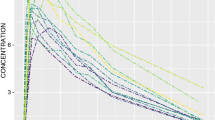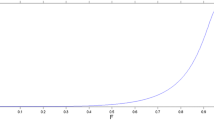Abstract
A computer simulation technique used to evaluate the influence of several aspects of sampling designs on the efficiency of population pharmacokinetic parameter estimation is described. Although the simulations are restricted to the one-compartment one-exponential model, they provide the basis for a discussion of the structural aspects involved in designing a population study. These aspects include number of subjects required, number of samples per subject, and timing of these samples. Parameter estimates obtained from different sampling schedules based on two- and three-point designs are evaluated in terms of accuracy and precision. These simulated data sets include noise terms for both inter- and intraindividual variability. The results show that the population fixed-effect parameters (mean clearance and mean volume of distribution) for this simple pharmacokinetic model are efficiently estimated for most of the sampling schedules when two or three points are used, but the random-effect parameters (describing inter- and intraindividual variability) are inaccurate and imprecise for most of the sampling schedules when only two points are used. This drawback was remedied by increasing the number of data points per individual to three.
Similar content being viewed by others
References
L. Endrenyi. Design of experiments for estimating enzyme and phamiacokinetic experiments. In L. Endrenyi (ed.),Kinetic Data Analysis, Design and Analysis of Enzyme and Pharmacokinetic Experiments, Plenum Press, New York, 1981, pp. 137–167.
E. M. Landaw. Optimal design for individual parameter estimation in pharmacokinetics. In M. Rowland, L. M. Sheiner, and J.-L. Steimer (eds.),Variability in Drug Therapy, Description, Estimation and Control, Raven Press, New York, 1985, 187–200.
E. M. Landaw. Optimal experimental design for biologic compartmental systems with applications to pharmacokinetics. Dissertation submitted in partial satisfaction of the requirements for the degree of Doctor of Philosophy in Biomathematics, University of California, Los Angeles, 1981.
D. Z. D'Argenio. Optimal sampling times for pharmacokinetic experiments.J. Pharmacokin. Biopharm. 9:739–756 (1985).
J. J. Di Stefano III. Optimized blood sampling protocols and sequential design of kinetic experiments.Am. J. Physiol. 9:R259–265 (1981).
J. J. Di Stefano III, T. K. Malone, and M. Jang. Comprehensive kinetics of thyroxine (T4) distribution and metabolism in blood and tissue pools of the rat from only six blood samples: Dominance of large, slowly exchanging tissue pools.Endocrinology 111:108–117 (1982).
C. Cobelli, J. J. Di Stefano III, L. Okalicsanij, and A. Ruggeri. Minimal sampling schedules for identification of dynamic models of metabolic systems of clinical interest: Case studies for two linear function tests.Math. Biosci. 63:173–186 (1983).
J. J. Di Stefano III. Algorithms, software and sequential optimal sampling schedule designs for pharmacokinetic and physiologic experiments.Math. Comput. Simulation 24:531–534 (1983).
F. Mori and J. J. Di Stefano III. Optimal nonuniform sampling interval and test-input design for identification of physiological systems from very limited data.IEEE Trans. Automat. Control 24:893–900 (1979).
L. B. Sheiner and S. L. Beal. Evaluation of methods for estimating population pharmacokinetic parameters III. Monoexponential model: Routine clinical pharmacokinetic data.J. Pharmacokin. Biopharm. 11:303–319 (1983).
W. J. Westlake. Use of statistical methods in evaluation ofin vivo performance of dosage forms.J. Pharm. Sci. 62:1579–1589 (1973).
C. M. Metzler, G. L. Elfring, and A. J. McEwen.A User's Manual for NONLIN and Associated Programs, Upjohn, Kalamazoo, MI., 1974.
G. E. P. Box and H. L. Lucas. Design of experiments in nonlinear situations.Biometrika 46:77–90 (1959).
S. L. Beal and L. B. Sheiner.NONMEM Users Guide, Parts I–VI, Division of Clinical Pharmacology, University of California, San Francisco, 1979–1989.
Author information
Authors and Affiliations
Additional information
Supported by the Scottish Home and Health Department (Biomedical Research Committee).
Rights and permissions
About this article
Cite this article
Al-Banna, M.K., Kelman, A.W. & Whiting, B. Experimental design and efficient parameter estimation in population pharmacokinetics. Journal of Pharmacokinetics and Biopharmaceutics 18, 347–360 (1990). https://doi.org/10.1007/BF01062273
Received:
Revised:
Published:
Issue Date:
DOI: https://doi.org/10.1007/BF01062273




